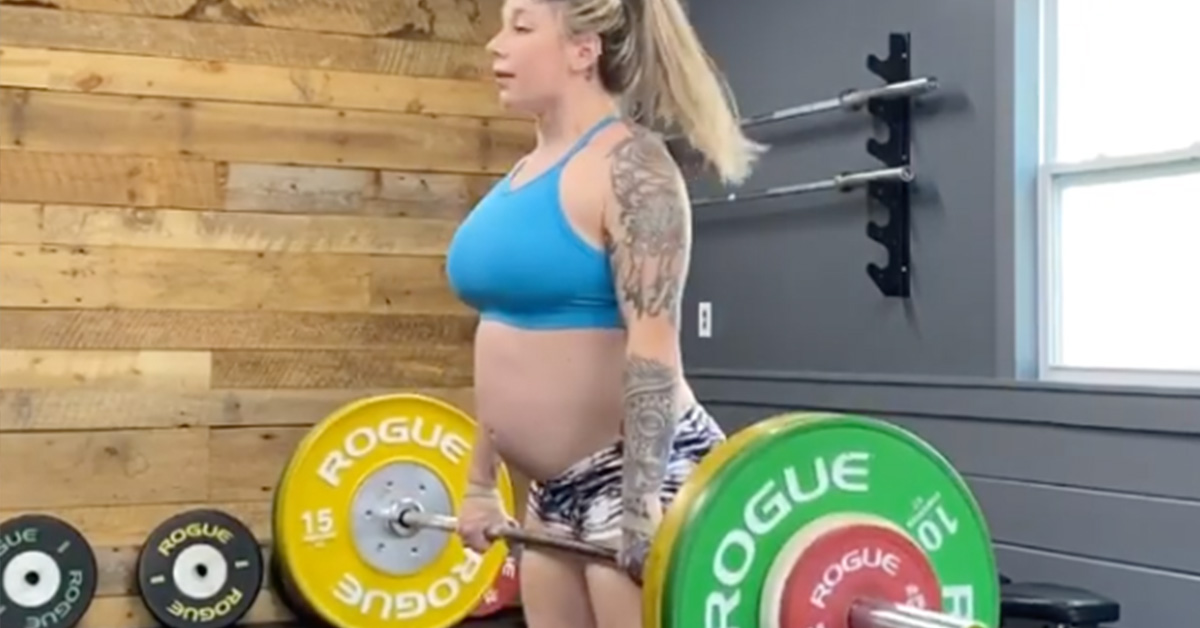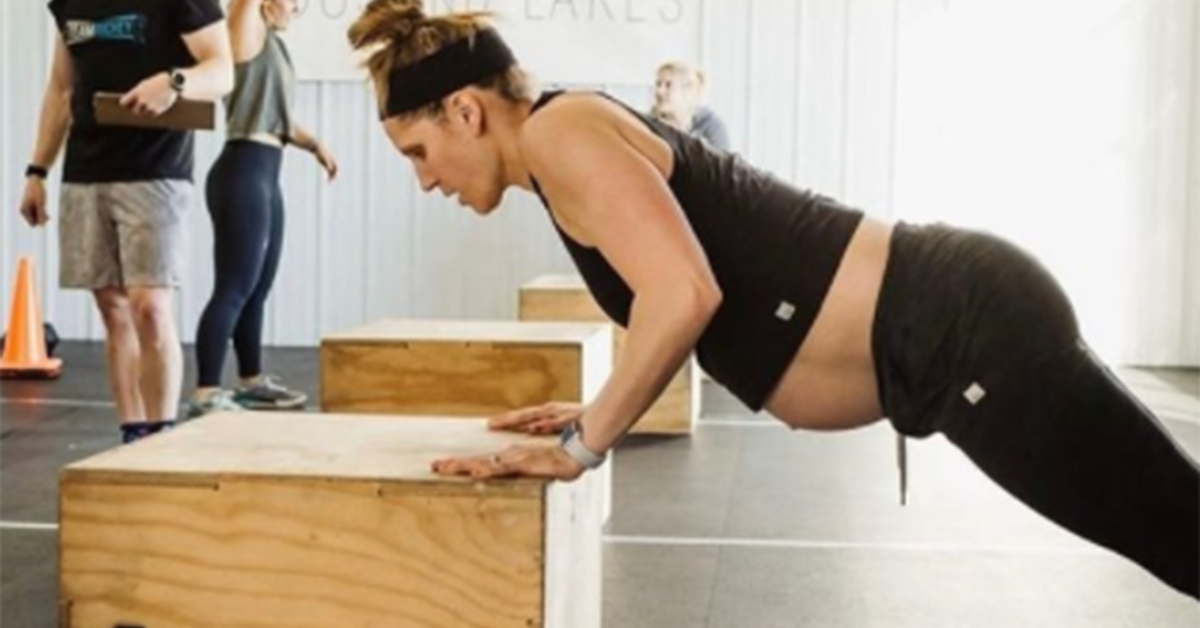Continuing to exercise while pregnant is a longstanding hot-button topic in the fitness community. More and more often, women — from Games athletes to everyday athletes — are choosing to keep up with their training throughout pregnancy. Surely, if you decide to continue exercising while pregnant, there are certain modifications you’ll eventually need to make. What are the do’s and don’ts of exercising while pregnant?
When training deliberately, functional fitness can help keep a woman fit and healthy during a tumultuous time in which her body is undergoing massive physiological changes. You probably wouldn’t run a marathon without training, right? Pregnancy, labor, and delivery are arguably the most difficult challenges a woman will go through in her life — so why not train for them? In this sense, it’s perfectly logical to continue working out during pregnancy.
Still, as any human should, you want to make sure you’re always doing it in a safe manner. We’ve compiled a list of the do’s and don’ts of exercising during pregnancy to help you through this incredible — albeit, challenging — time.
Do: Listen to Your Body
Your body will be extremely communicative during pregnancy. If you push too hard during a workout, your body will send signals such as localized pain and discomfort, downward pressure in the pelvic area, or a pulling sensation in your joints or ligaments due to the hormone relaxin, which increases the elasticity of ligaments in preparation for childbirth.
Don’t ignore these signals. If running causes cramping, jump on a rower or an Assault bike instead. If explosive movements cause discomfort, try practicing them strict. If box jumps cause pelvic pressure, step up instead.
The beauty of functional fitness is its infinite scalability, and during pregnancy, this will come in extra handy.
Don’t: Let Your Ego Cloud Your Judgement
Pregnancy is not the time to set new PRs or aim for the top of your gym’s leaderboard. If you’re used to being one of the fittest in class, use this opportunity to take the pressure off and just enjoy working out with friends.
Understandably, it’s difficult for some to put ego aside. Chances are you have a bit of a competitive streak if you do functional fitness in the first place. When you feel your ego creeping up, remind yourself this is a time to move intentionally to support your body and the baby growing inside you.
Fitness can be extremely beneficial mentally and physically in pregnancy, but you’ve got to check your ego at the door.
Do: Practice More Strength Work
We’re not talking one-rep maxes here, but building strength with moderate weights will greatly benefit you in pregnancy, labor, delivery, and recovery.
Building strength in your legs, specifically, by continuing to squat (as long as it’s comfortable) can benefit you during labor — many women deliver their babies in a squat position!
During pregnancy, there is increased pressure on the pelvic floor muscles and they can become damaged during labor and delivery. Frequent squatting during pregnancy can help increase pelvic floor strength that will aid a woman all the way through her recovery.
Squatting can also help prevent the lower back pain that is so common during pregnancy. Strong gluteal muscles aid in stabilizing your pelvis by supporting your sacroiliac joint. Strengthening these muscles will help prevent the pain often caused by ligaments loosening because of the hormones relaxin and progesterone.
Remember to breathe through each lift and don’t rush. Quality matters.
Don’t: Redline During WODs
A popular warning when exercising during pregnancy is the idea you have to keep your heart rate under 140 beats per minute. While this has shown to be unfounded, the intention behind the caution is good.
Your body is working overtime during pregnancy to make a human, so your normal ability level will naturally decrease. You may find yourself out of breath much sooner or needing to take more rest breaks. This is your body’s way of communicating. While a heart rate above 140 isn’t necessarily indicative of doing too much, having the awareness to keep your body away from undue stress is beneficial.
Make your workouts more about moving intentionally and getting a sweat on while boosting your mood, and less about reaching the place that makes you collapse on the floor at the end.
Do: Go Back to the Basics
Pregnancy is a great time to master the basics again! So you can squat 100 kilos and do 10 muscle-ups in a row — but maybe not while you’re carrying a baby.
It’s easy to ignore the basics when you are proficient at high-skill movements. Pregnancy is a great time to revisit the foundational movements of functional fitness. This will undoubtedly benefit you when you’re ready to swing on the rings, get inverted, or get under a heavy barbell again.
Revisit the mechanics of the air squat and perfect the movement. Sub ring rows for pull-ups and remember to maintain virtuosity in each movement. Replace explosive movements that may no longer feel comfortable with strict movements. Strengthen your strict press and master beautiful position at light weights. You’ll thank yourself later.
Don’t: Push Through Pain
Pregnancy is not the time to “push through the pain,” as we often do during tough workouts. Pain — especially physical pain or discomfort — during pregnancy is your body’s way of telling you that you’re doing too much. You’ll be pushing through the pain (literally) soon enough during labor and delivery, so don’t overdo it beforehand.
If in the midst of a tough workout you start to feel the twinges of more than mild discomfort, slow down and breathe. Find a pace you can sustain that keeps you moving but doesn’t push you to a place you might regret. Try not to ever come out of a workout wondering if you did too much. When in doubt, scale further, and remember why you’re doing this — to keep mama and baby healthy!
Do: Consider Your Own Unique Circumstances
Every pregnancy and person is different, so what works for one pregnant woman may not work for another. When you attack workouts, consider the state of your pregnancy or any complications you’ve had.
Talk to your physician about your training and listen to what they have to say. Talk to your coaches and do your own research! There are many invaluable resources out there that can influence your training during pregnancy. You can also check out the CrossFit Journal for some great articles to obtain the knowledge and confidence you need to have a fit pregnancy.
Main image: Kristin Pope/Instagram

















